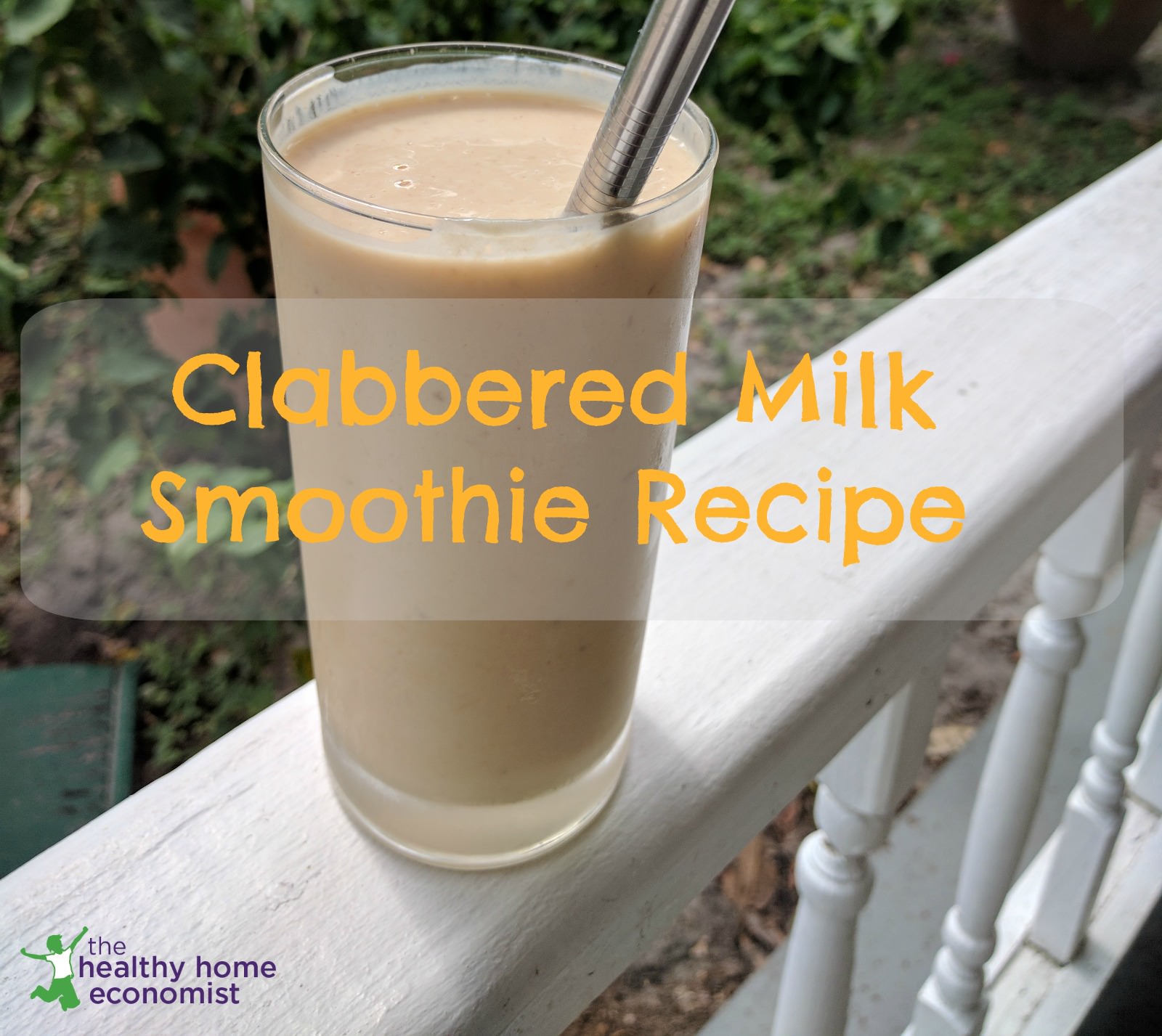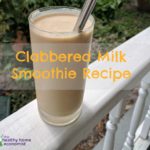 Did you know that a clabbered raw milk smoothie tastes very similar to one made with drinkable style yogurt? This is perhaps the best and most economical way to use farm fresh milk that is no longer at its best for drinking!
Did you know that a clabbered raw milk smoothie tastes very similar to one made with drinkable style yogurt? This is perhaps the best and most economical way to use farm fresh milk that is no longer at its best for drinking!
In 2004, I wrote an article for Wise Traditions journal titled Learning to Maximize the Use of Your Real Milk and Cream. The basic premise of the article is that Real Milk and Real Cream (as in fresh from a grassfed cow), do not go bad, they sour.
Big difference.
Pasteurized milk from the store that goes bad must be thrown out. It is putrid and can make you sick if you consume it. It is full of pathogenic bacteria.
Real milk fresh from a happy, healthy, pastured cow that has soured has not gone bad. It has clabbered which means the good bacteria have simply consumed a good portion of the milk sugar (lactose), thereby giving the milk a more yogurt-like smell and taste.
Nevermind that you’ve probably never heard of clabbered milk let alone consumed it. Fact is, clabbered sour milk is totally fine and healthy to eat. Do not throw it out! There are many uses for such a wonderful food, which that article details.
I’ve gotten a lot of mileage out of that piece over the years and have forwarded it to many people who are using Real Milk for the first time and are unaccustomed to souring as opposed to the putrification of store milk.
Clabbered Milk Smoothie
You can imagine my surprise when I discovered yet another use for clabbered milk that wasn’t even mentioned in that article, yet is probably the BEST use of clabbered milk that I have found to date!
How about using clabbered milk for smoothies!!!
Some of you are probably rolling your eyes right about now thinking, “Like, I’ve been doing that for years already!”
I should have been doing this for years, but I am so rarely out of raw kefir or yogurt for my smoothies that it literally never crossed my mind as an idea.
The thought came to me for the first time just a few days ago when we were completely out of milk. I didn’t have any kefir or raw yogurt either. The next farm delivery was a couple days away.
Buying a lower quality product from the store to get me through? Not an option for me. I’m waaaayyyy too much of a dairy snob for that.
Moreover, I was just dying for a smoothie.
I thought to myself, “Hey, maybe I could use some of that lightly clabbered milk in the fridge, after all it is pretty similar in texture and taste to raw yogurt!”
I have said this before and I’m sure I will say it again, sometimes the most obvious stuff just takes awhile to bubble to the surface! At least that’s how my brain works.
In case you’re wondering, here’s my favorite smoothie of the moment.

Clabbered Milk Smoothie Recipe
Nourishing recipe for a clabbered milk smoothie that is an economical way to use farm fresh raw milk that has slightly soured and loaded with probiotics.
Ingredients
- 1 pint plain kefir preferably raw
- 2 bananas ripe
- 2 Tbl raw honey
- 1/2 tsp vanilla extract
- 1/4 cup creamy roasted peanut butter
Instructions
-
Mix all ingredients together in a mason jar using a handheld blender.
-
Serve immediately and enjoy! Refrigerate leftovers.
More Smoothie Recipes
- Peanut butter banana smoothie
- Kefir smoothie
- Smoothie alternative
- Raspberry lassi recipe
- Coconut milk smoothie recipe
Sarah, The Healthy Home Economist








Hi Erika,
Yes, clabbered milk is like kefir just does not have the same beneficial strains of bacteria.
The cream will continue to culture in your fridge so if you wait a while to make butter with it, you will end up with cultured butter instead of plain butter.
You can leave the buttermilk on the counter for a day or two to culture it, then you can use it for soaking your flour for pancakes, waffles, and the like. If you make the butter with cultured cream (cream that has naturally soured in the fridge is also cultured cream) then the buttermilk is already cultured and you can put it straight in the fridge to use later for soaking without leaving on the counter for a couple days. Hope this helps!
Sarah, thank you! That is really helpful to know. Couple more questions …
1. When the milk is clabbered, you'd use that LIKE kefir, even though technically it's not because it doesn't have the kefir grains in it … is that right? Would it taste similar? I'm assuming that it just wouldn't have as many strains of beneficial bacteria. Is that really the main difference?
2. Also, I'm really wanting to use my cream from the raw milk to make butter…but I don't like to take all of the cream away from the milk! 🙂 Right now, I have a separate jar that I am keeping some of the cream in, but is there a point when the cream might be too sour to use for butter?
and…one more — for now! 🙂
3. Do you have some suggestions for different ways to use the buttermilk left after making butter? (Because this would be different than the liquid whey, right?)
Some of these questions probably seem so simple, but this is all so new to me! Thanks so much for your help. I so appreciate your guidance!
Hi Sarah – another question, sorry! I was just curious – can you use slightly soured milk to make yogurt with or should it be fresh? I've got some raw milk in the fridge that smells a little sour (is almost a week old) and I haven't had a chance to make yogurt out of it yet. Should I wait to get fresh milk or use this? Thanks!
Hi Erika, so glad you are finding the blog and video classes helpful! Raw milk that has clabbered can be used for up to six months in the fridge. If you ever get mold on it, then it should be tossed, but otherwise, it just gets stronger in flavor and chunkier over time. You may find it gets so chunky that it is no longer so good for cooking, but is still good for smoothies as it has a yogurt like texture.
Real milk can always be clabbered but depending on the freshness of it, it may take more or less time sitting on the counter.
Uhoh! I think my comment just got deleted when my safari quit! I apologize if I post twice!
Hi Sarah, first of all, thank you so much for your blog! I have found your posts to be so helpful, especially your videos. We have only recently been making healthier changes in the kitchen, and your videos honestly make it seem LESS overwhelming. You SHOW how easy it can be to make "homemade." …and I so, so appreciate that! I am learning so much from you!
Our family just purchased our first gallon of real milk about a week or so ago, and we love it! I am so excited to use our milk for more than just drinking!!! I do have a couple of questions, though:
1. Is there ever a point when the milk is too sour and actually spoils? If so, what do you look for, smell for, etc.?
2. When you first get your milk, is it too fresh to clabber, or do you just leave it out like you did in the ketchup/whey video?
Thanks so much for your advice!
Hi Sarah, first of all, let me just say how much I am enjoying your blog, esp. the videos where you SHOW how easy it is to make "homemade." Our family is slowly but surely making healthier changes, and honestly, you make it feel less overwhelming and really do show how easy it can be. THANK YOU!
We finally bought our first gallon of REAL milk about a week or so ago. We love it, and I am so excited to use our milk for many different things! I never thought I'd look forward to milk souring! 😉
Just a couple of quick questions —
1. Is there a point when the milk is too soured (when it actually does go bad)? If so, what do you look for, smell for, etc.?
2. When you first get the milk, is it too fresh for it to clabber to use for other purposes, or should you just leave it out like you did in the ketchup/whey video?
Again, thank you so much for your posts. They have really been helpful to me!
Hi Kelsey, some folks do better on goat milk than cow. But, not everyone finds goat milk to be more digestible by any means. Cow milk tastes better to most people which is why it is more popular, I think.
We have goats and I make goat’s cheese out of the milk. I don’t like the taste of goat’s milk by itself, but the cheese is great.
Hi Sarah, I just had a question. I notice that nobody ever talks about goat's milk as opposed to cow's milk on all the blogs I've been reading. Is there a reason for that? I'm just curious because I can't have cow dairy, but can have goat milk and am looking into a goat share. I've always heard that goat's milk is even healthier than cow's milk since it is more digestible – are there any benefits of cow's milk over goat's milk, or is it just that cow's milk is more popular?
This is the exact smoothie we had for breakfast this morning, except I added a little organic cocoa powder and a few drops of chocolate flavored stevia. A delicious weekend treat!
Unfortunately, I do not have access to raw milk. The closest I get is lightly pasteurized, non-homogenized. But, this smoothie looks like a good way to use up that milk kefir I've been making! I'm sure the kids would love it. Thanks!